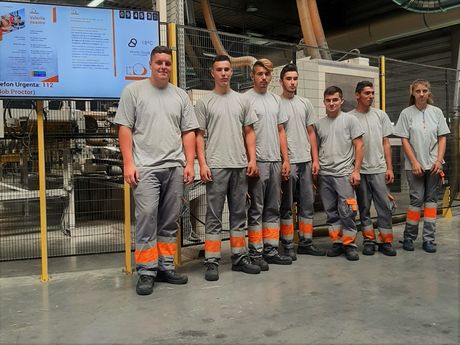Final practice: vocational education students finish their training in the Holzindustrie Schweighofer mills
Practice makes perfect, that’s why practical training stages in the company’s mills include more and more young people each year.
The Schweighofer Scholarships recipients from the Moinesti Technical High-School near the end of the programme
A few weeks before the certification exams, the students in the vocational education project supported by Holzindustrie Schweighofer at the Gr. Cobalcescu Technical College in Moinești said their goodbyes to the company’s Radauti sawmill.
Each year, the students had extended practical training stages in the company’s units, not just in neighbouring Comănești, but also in Rădăuți, Sebeș, and Reci.
“What can I say, since 2016… we grew a lot,” said Cosmin Cata, one of the students preparing for an electrical career. “It’s a wonderful profession, if you are passionate about it, it will bring you a lot of satisfactions. We are the lucky ones, we had the opportunity to train in these big industrial plants, we faced all kinds of challenges here.”
Established in 2016, the class at the Technical High School in Moinești has been preparing 28 students for the professions of electrician and mechanical locksmith. Apart from practical training in the Holzindustrie Schweighofer units in Romania, they benefitted from a completely renovated school workshop, with brand new instruments and equipment, as well as monthly stipends worth as much as 700 lei (about 150 Euro).
While other high school students who completed the 11th grade now enjoy their vacation, the vocational education students are closing in on the final exams.
They are coming back to school, will go through their schoolwork again, and, at the end of July, they will be tested on the practical knowledge and abilities they got, at school and in the mills. Specialists from the company will take part in the exams.
“I would summarize this entire period in two keywords: experience and education,” said Titi Vizitiu, the electrician’s teacher. “Apart from what we teach them, us as well as your colleagues, about the jobs they chose, they benefit a lot from all kinds of experiences which complete their education, at a crucial time, when they prepare for adulthood and independence.”
Although an important life cycle is coming to a close, the students are optimistic. After graduation, all those willing to join the company will receive job offers.
The young carpenters from Comănești carry the wood tradition forward
This year, a group of students from the Technical College D. Ghika in Comănești also had practical training in the local blockboard factory owned by the Schweighofer Group. The students, who are preparing for a universal carpenter vocational degree and are in their final year as well, already spent three weeks in several sections of the plant.
“When they started here, everyone’s reaction was that it’s extraordinary,” said Gheorghe Pașcu, the students’ class master and their supervisor during practical training. “Technology is like they never seen before, although they had some practical training with other wood companies in the area. Everything is run by computers. In Baco 4, for instance, if I were a worker there, I think I would die of boredom.”
Tall, blond and shy, Roxana Bîlbîie is the only girl in the group. She has been working in the core production sector, Baco 3, where she worked at the belt conveyor for the timber strips.
“I find it easy enough,” says Roxana. “I watch the belt, I have clear quality criteria, I know what I have to do. We get training and support.”
Roxana already said she would like to get a job at Holzindustrie Schweighofer Baco after graduation.
“Although it’s an area with a rich tradition in wood working and wood processing, lately there’s been a marked decrease of interest in this profession,” says Mr Pașcu. “Many children, many parents think that wood processing means only ‘lifting logs’ on their backs, in the forest. But, if they come and see what industrial wood processing is like in a modern factory, I believe we have a chance of reviving the wood industry, all along the Trotus River Valley.”
[Translate to Deutsch:] Students in the vocational education project supported by Holzindustrie Schweighofer at the Gr. Cobalcescu Technical College in Moinești said their goodbyes to the company’s Radauti sawmill.

